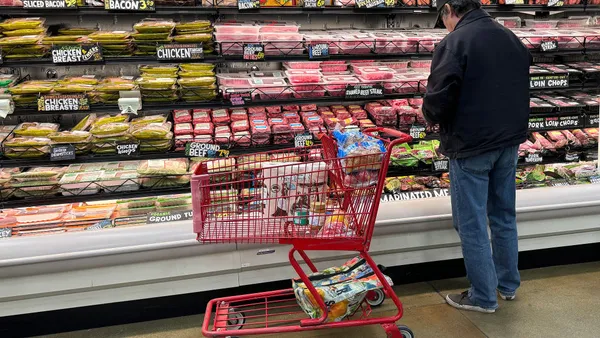Dive Brief:
- DG Fresh, Dollar General’s effort to increase the amount of fresh and frozen foods in its stores, is the company’s top sales driver and is likely to remain in that position, Dollar General CEO Todd Vasos said Wednesday during the Barclays Global Consumer Staples Conference. Dollar General’s effort to expand its assortment of non-consumable products, known as NCI, represents the retailer's second-largest growth driver, Vasos said.
- DG Fresh is also helping the retailer increase distribution of private label products. The company's Better for You brand is now in 6,000 stores, and should be in 7,000 by the end of 2020, Chief Operating Officer Jeff Owen said during the event.
- Dollar General is also taking advantage of the expansion across its fleet of the Fresh initiative, which has helped the company reduce the cost of distributing frozen and refrigerated products, chief financial officer John Garratt said during the conference. The company is in position to reap further benefits as it serves more stores from its existing distribution centers, Garratt said.
Dive Insight:
Dollar General has been rapidly expanding its ability to handle the distribution of frozen and refrigerated goods like deli and dairy products on its own as part of a drive to increase its margins. About 5,500 of the retailer’s stores were part of the initiative at the end of 2019, and the company expects to epand DG Fresh to 14,000 locations by the end of this year, up from 12,000 at the conclusion of the second quarter.
Helped by pandemic-driven shopping, net sales at Dollar General rose 24.4% in Q2, to $8.7 billion, the retailer reported Aug. 27.
“If you think about it, we said we were in the 6th and 7th inning of a baseball game if you will, before we started to do a lot of the work and especially before DG Fresh,” Vasos said during the conference, noting that the company has also been investing in higher-capacity coolers in its stores. “We've turned the clock back and we're actually now only in the 4th inning. We see a tremendous runway ahead of us there.”
Beyond improving its ability to efficiently distribute perishables to its stores, Dollar General has seen a shift in the way consumers engage with its stores, according to the company. Sales figures show that customers have stopped depending on visits to Dollar General to fill their pantries with essential items like paper goods and food, as they were in March and April, and are now coming in to replenish their stocks before running out, Vasos said.
“We are seeing through our credit card data and what she's telling us … that she's made multiple trips over the last few months into the brand to buy her needs, she likes what she sees and she's continuing to want to shop us,” Vasos said.
Dollar General is also attracting slightly higher-income consumers, and these shoppers represent the company’s fastest-growing customer set, according to Vasos. The company is also attracting people who Vasos described as more digitally savvy.
“We are really pleased with our positioning right now and where we sit, as we move through COVID. But even prior to COVID, when you start to think about who our core consumer is, and then also those consumers that we've seen trade down into the brand, even before COVID. Our fastest growing segment by our percentage basis was really a higher income consumer,” said Vasos.
Vasos also said the company is having success attracting customers who are more engaged online.
“Our digital programs are reaching a whole new customer base that we knew was out there, but we quite frankly weren't tapping into them through the old analog way that we went to market through advertising and brand awareness. Now with digital, we're able to tap into that and we’re seeing her come into the store and we're seeing multiple purchases,” Vasos said.
Dollar General’s in-store pickup service, which is now in about 16,000 stores, is also doing well, in part because its customer base is becoming more comfortable with online services. Vasos said the company feels it is in a strong competitive position compared with grocery stores and other large retailers because its shoppers typically order only five or six items at a time.
“These are very manageable baskets and … for our employee to shop that for the consumer is very, very quick,” Vasos said, adding that when customers come in to pick up their orders, they are frequently buying other items.










